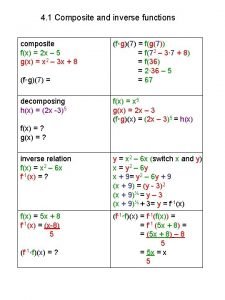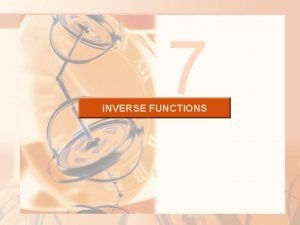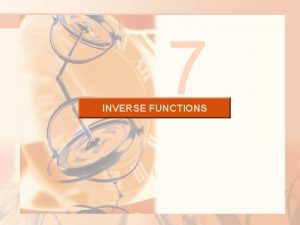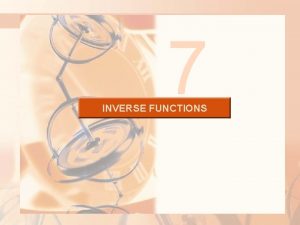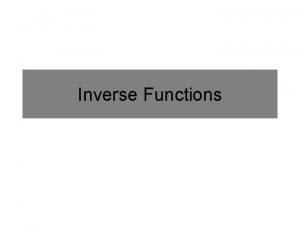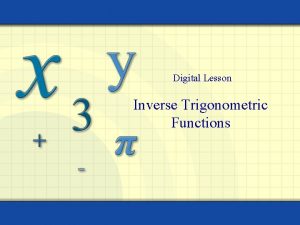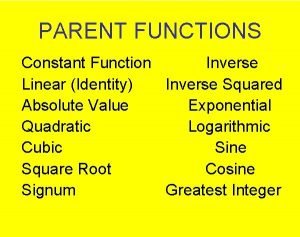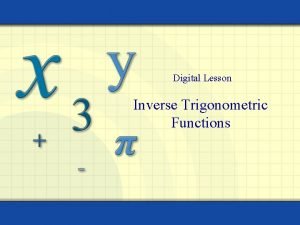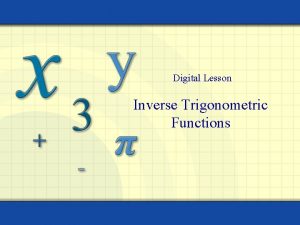Inverse Functions The inverse of a function is










- Slides: 10


Inverse Functions The inverse of a function is a function which “undoes” what the original function did. It’s graph is the reflection of the original graph across the line y = x. The graph can be found by interchanging the coordinates of the ordered pairs in the original function. The inverse of a function is written as f -1(x) and read as “the inverse of f at x” or “ f inverse of x. ” When x and y are interchanged in the equation of a function: • The coordinates of the points that satisfy the equation are interchanged. • The graph of the function is reflected in the line y = x. To determine the inverse of a function: • Interchange x and y in the equation of the function. • Solve the resulting equation for y.

Graphing the Inverse Function Note: If the ordered pair (3, 6) is on the graph of the function f(x), then the ordered pair (6, 3) will be on the graph of the inverse function, f -1(x). Example : Find the inverse of the function f(x) = 4 x - 7. ) -1 (x f (-3, 1) (-7, 0) y= x f(x) Interchange the x and y values. y = 4 x - 7 x = 4 y - 7 x + 7 = 4 y x+7=y 4 (1, -3) (0, -7)

Verifying an Inverse If two functions f(x) and g(x) are inverses of each other, then f(g(x)) must equal x AND g(f(x)) must equal x. Verify that the functions f(x) = 4 x - 7 and are inverses. f(g(x)) must be equal to x. g(f(x)) must also be equal to x. f(x) = 4 x - 7 g(4 x - 7) = (x + 7) - 7 =x =x Since f(g(x)) and g(f(x)) are both equal to x, then f(x) and g(x) are inverses of each other.

Graphing a Function and Its Inverse Graph f(x) = x 2 + 1 and its inverse. (-2, 5) (2, 5) The graphs are symmetrical about the line y = x. (1, 2) For the function: Is the inverse a function? Could the domain of f(x) be restricted so that the inverse is a function? x y>1 For the inverse: Domain: x > 1 Range: (5, 2) (0, 1) y= Domain: Range: (-1, 2) (2 , 1) (1, 0) (2, - 1) (5, -2)

To find the inverse of a Function 1. Use the Horizontal Line Test to see if an inverse function exists. (That is, will the inverse be a function? ) 2. Replace f(x) with y. 3. Exchange x and y then solve for y. 4. Replace y with f-1(x). 5. To check, calculate f(f-1(x)) and f-1(f(x)) to see if they both equal x. 6. You can also check by graphing. –> Are the graphs symmetric across the line y=x?

Replace f(x) with y. Exchange x and y. Solve for y. Replace y with f-1(x). Check.

Check by graphing.

The graph of f(x) and the graph of f-1(x) should reflect over the line y=x. y=f(x) y=x y=f-1(x)

Check with composition of functions. f f-1 f

